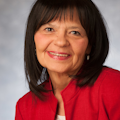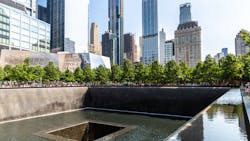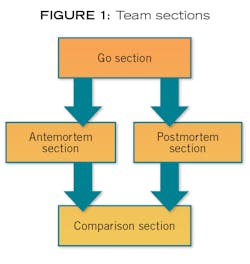9/11: Dental hygienists' incredible contributions to identification efforts
Editor's note: Winnie Furnari, MS, RDH, FAADH, FAAFS, FADE, was well-known for her work in forensic odontology and had a tremendous impact on the field. She wrote this article in 2021, and it has since been updated. Read more about Winnie's legacy in dentistry.
Most anniversaries are celebratory and tend to commemorate a joyous event. But some anniversaries commemorate tragedies, and these should also be recognized. September 11 marks the 22nd anniversary of the terrorist attacks on the United States. Four planes were hijacked that morning—two that departed from Boston, one from Newark, and one from Washington, DC.
The attacks occurred in New York, Washington DC, and in the air as a plane fell into a field in Pennsylvania while possibly en route to the White House. Two of the planes flew into the World Trade Center buildings, one flew into the Pentagon, and the fourth destination is still not known. This was the worst terrorist attack on American soil in our nation’s history, and nearly 3,000 people lost their lives.1
It’s likely that some of you reading this were not born yet or were not old enough to remember 9/11. Nonetheless, you’re aware of it. For those of us who remember and witnessed September 11, 2001, its images are forever seared into our memories. Our nation came together like it never had before. People lined up at hospitals to donate blood. Fire and police personnel were thanked and applauded in the streets. Houses and cars displayed the American flag. For some time, the walls of Manhattan buildings were covered with posters of missing persons. These displayed the hopes of families whose loved ones could not be found. The sad truth is that most people perished and were returned to their families after they were found and identified.
You might also be interested in: Forensic dentistry: A meaningful opportunity (that you may not know about)
Many, many volunteers offered to help with the intensive labor or wherever they were needed. I witnessed this and can vouch for the fantastic response from the dental community. It was certainly the largest outpouring from the dental profession that most of us had ever seen, where we offered our skills and volunteered in any way we could.
The major forensic task given to the medical examiner of New York was identifying people. All the teams in his office were called in, including the dental identification team. Forensic dentistry means dentistry performed to assist the legal community. The NYC team grew as the task grew, and the days turned into weeks and months. Members of the dental community nationwide offered to come to New York to assist. This was truly an example of how unselfish and compassionate the dental community can be, and what an asset it is to forensics.
The core New York team, of which I’m a member, was prepared to work on multiple fatalities, but the numbers on 9/11 were unprecedented and nothing we could have ever prepared for or expected to experience. But we did know our first priority was to send loved ones home to their families. So, we put our emotions aside and set out to do this enormous task.
We shared teamwork in sections
I had to call insurance companies, dentists, and foreign countries to gather whatever was available for patient records to help create dental profiles of missing persons. Citizens from 78 countries lost their lives in the World Trade Center.1 Most of their medical records were in languages other than English. The records also had different numbering systems, abbreviations, and chart systems. Interpreters were called in to assist. One hygienist translated all the Japanese charts received.
The next section of the team is the postmortem section. This is where hands-on exams, radiographs, and charting are done on the human remains. There was always something to learn and someone with dental expertise always had something new to share with us.
Another section is the comparison section. This is where computer software programs are used to help find possible similarities in dentitions from the ante- and postmortem records entered in the program.
Because of the enormity of the situation, we instituted an administrative section that consisted almost entirely of dental hygienists. We created volunteer schedules. We created databases that kept information and contacts for the team members and other volunteers. All filing, receipt of phone calls, faxes, and tracking of dental personnel hours were done entirely by dental hygienists. Yet we still worked in each section when needed. We worked with dentists to chart remains, expose x-rays, chart records, and enter ante- and postmortem information. Dentistry was responsible for several hundred positive identifications with multiple modalities.2
September 11 Memorial and Museum
As we observe the 20th anniversary of 9/11, the world is confronting new global challenges that test our capacity for spirit, compassion, responsibility, and resilience. Our obligation to commemorate, educate, and inspire is more urgent than ever. Throughout the country, states have in some way erected memorials for reflection. In New York, the National 9/11 Memorial and Museum honors victims of both 9/11/01 and 2/26/1993, when a car bomb exploded in the World Trade Center parking garage.
The National 9/11 Memorial and Museum offers a world-class learning experience that ensures that a new generation will learn about this transformational moment that affirmed the best of humanity in the face of the worst and helped to shape the world in which we live. It stands as a powerful tribute to the victims and the power of the human spirit. It is important to New York, our country, and the world.3
What lies ahead
The truth is that 9/11 did not end on 9/11. We are still inspired by the stories of courage, compassion, and resilience of dentistry and dental hygiene. We vowed never to forget, and we must stand by that promise. I’m honored to have played a part with my colleagues in the identification efforts, and to be a part of the forensic dental community. The community has more than 100,000 professional and volunteer responders who spent countless hours combing through the rubble amid acrid smoke and polluted air hoping to find survivors. Now, 68 cancers and many respiratory illnesses have been linked to those toxins.4 My own cancer has been certified as 9/11-related, but I would not hesitate to help again because dental hygiene has contributions to make outside the private practice.
Though 20 years have passed, dental identification teams still exist. In New York, technology has replaced or changed many protocols, but the basics remain the same—use the combined knowledge, skill, and expertise to return loved ones to their families, and assist law enforcement.
One of my hygiene mottos is, “A success for one hygienist is a success for us all.” Share in this success. Hygienists don’t look for or need public recognition for their work. Together we can do much and we can make history. Our contributions speak for themselves. On this 20th anniversary, I acknowledge every dental professional who volunteered. Everyone made an impact on forensic odontology, dental hygiene, and humanity.
Resources
1. American Society of Forensic Odontology asfo.org
2. State and local forensic societies
3. Disaster Mortuary Operational Response Team at phe.gov/preparedness/responders/ndms/ndms-teams/pages/dmort.aspx
4. Continuing education courses in forensics
References
1. September 11 attacks. History. August 25, 2018. Updated September 11, 2020. Accessed March 10, 2021. https://www.history.com/topics/21st-century/9-11-attacks
2. World Trade Center Operational Statistics. NYC.gov. Accessed March 10, 2021.
http://www.nyc.gov/html/ocme/downloads/pdf/public_affairs_ocme_pr_WTC_Operational_Statistics.pdf
3. 9/11 Memorial and Museum. 911 memorial. Accessed March 10, 2021. https://www.911memorial.org/
4. 9/11 World Trade Center Health Program. Centers for Disease Control and Prevention. Updated May 14, 2021. Accessed March 10, 2021. https://www.cdc.gov/wtc/conditions.html
9/11 dental hygienist volunteers
Peggy Applegate
Nancy Barnes
Dolores Belrose
Fay Brown
Cindi Callahan
Elisha Dang
Patricia Delaney
Andrea Doria-Russo
Shizuko Egami
Winnie Furnari
Jeannie Guzman
Loreen Indelicato
Mona Itkowitz
Bernice Iwinski
Juliana Kim
Lisa Laramee
Dineen Manz
Linda Matuseski
Kelly Milashoukas
Linda Obermeyer
Joann Pecorella
Diane Penola
Mary Ryan
Geri Rau (deceased)
Barbara Simon
About the Author

Winnie Furnari, MS, RDH, FAADH, FAAFS, FADE
Winnie Furnari, MS, RDH, FAADH, FAAFS, FADE, once served as president of the American Academy of Dental Hygiene. She also served as president of the New York and New Jersey Dental Hygienists Associations and in numerous capacities in professional organizations. She was a clinical professor at NYU College of Dentistry and taught a forensic dentistry/catastrophe preparedness course in the baccalaureate program. Furnari was awarded national and international awards and recognitions for her dental hygiene achievements. As a member of the NY City Dental Identification Team, she participated in several multiple-fatality responses.

